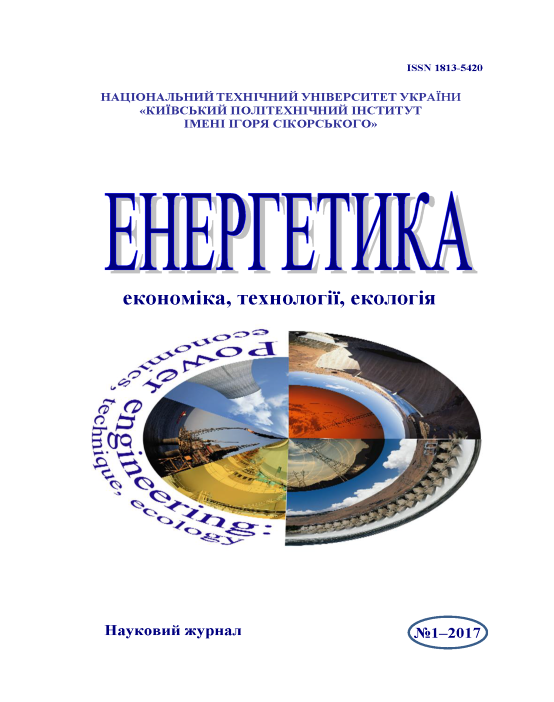IMPROVING EFFICIENCY OF HEAT UTILIZERS OF SMOKE GASES OF BOILER PLANTS AT THE EXPENCE OF WETTING OF BLOWING AIR
DOI:
https://doi.org/10.20535/1813-5420.1.2017.102819Keywords:
hot water boiler, flue gases, heat recovery units, blowing air, humidity, enthalpy, moisture content, heat flow, dew point temperature, energy and environmental efficiencyAbstract
Analyzed the types of heat utilizers of flue gases that can be installed on hot water boilers of heating boilers, and consumers of heated water. An examination of the heat balance utilizer equation showed that increasing of the flow of flue gases designated heat or possibly by increasing their enthalpy input, or enthalpy decreasing output. In a previous study was found that deep cooling by using flue gas cascade Heater installation (first use "dry" and "wet" mode) compared to the operation of the "dry" mode for the boiler with three hot water boilers KV-HM- 10 for the heating season is achievable to increase in the number of heat utilized about 22 thousand. GJ / year. The method and the results of calculations of energy and environmental efficiency heat recovery units of surface water boilers at higher flue gas enthalpy input and deep cooling flue gases. It was established that the increase of enthalpy inlet perhaps by increasing the moisture content of the flue gases is achieved blowing moisture in the air in contact sprayer or nozzle cells. The calculations were moist air moisture content of 40 g / kg SP, having moisture content of the flue gas inlet heat 160 g / kg SG, dew point temperature of 60 ° C and the minimum temperature of the flue gases at the outlet of heaters that work in "dry" mode, 65 ° C. To eliminate the condensation of water vapor from the flue gases in the gas path and stack provides the flow of flue gas from the initial temperature to bypass duct. The resulting dependence of bypassing, assigned to specific flow heaters and heat gain from its final temperature flue gas cooling in case blowing humidifying air at different initial temperatures in the range of 140 - 190 ° C. It is shown that the maximum flow of heat in designated facilities meet Heater Flue gas temperature at the outlet, which decreased from 28 ° C (at = 140 ° C)to 23 ° C (at = 190 ° C). The minimum rate of bypassing on cooling flue gases to temperatures 23 - 28 ° C is 0.25 - 0.33. The maximum increase in heat flow corresponds cooled flue gas temperatures 23 - 28 ° C and is about 10%. The total maximum flow allocated to installations Heater heat during deep cooling of flue gases in the event blowing humidifying air for hot water boiler with three hot water boilers KV-GM-10 is 5826 kW. The total annual amount of heat is utilized 42,398 GJ / year, and its growth through air humidification blowing 4400 GJ / year (about 10%). It is also shown that the moisture blowing air entering the gas burners on boilers, discharge of nitrogen oxides from the flue gases is reduced by about 2 times.
References
Роддатис К.Ф. Справочник по котельным установкам малой производительности / К.Ф.Роддатис, А.Н.Полтарецкий; под. ред. К.Ф.Роддатиса. – М.: Энергоатомиздат, 1989. – 488 с.
Аронов И.З. Контактный нагрев воды продуктами сгорания природного газа / И.З. Аронов. – 2-е изд., перераб. и доп .– Л. : Недра, 1990. – 280 с.
Кудинов А.А. Энергосбережение в теплогенерирующих установках / А.А.Кудинов. – Ульяновск: УлГПУ, 2000. – 139 с.
Боженко М.Ф. Енергозбереження в теплопостачанні : навч. посіб. / М.Ф. Боженко, В.П. Сало. – К. : НТУУ «КПІ», 2008. – 268 с.
Боженко М.Ф. Каскадна утилізація теплоти димових газів опалювальних водогрійних котелень / М.Ф.Боженко, І.Я.Перевьорткіна // Енергетика: економіка, технології, екологія. – 2016. - № 1. – С. 81-88.
Экологически чистая теплоутилизационная установка с контактними теплообменниками: отчет о НИР (заключит.) : 25-11 / Институт проблем энергосбережения НАН Украины; рук. Л.Г.Семенюк; исполн. : А.А.Михайлов и др. – Киев, 1994. – 64 с. – Инв.№ 1194.
Безлюдный П.П. Определение температуры точки росы продуктов сгорания природного газа / П.П. Безлюдный, Л.Г. Семенюк, В.Н.Николаев и др. // Изв. вузов «Энергетика». – 1986. - № 12. – С. 89-90.
Семенюк Л.Г. Получение конденсата при глубоком охлаждении продуктов сгорания / Л.Г. Семенюк // Промышленная енергетика. – 1987. – № 8. – С. 47–50.
Алабовський О.М. Проектування котелень промислових підприємств: курсове проектування з елементами САПР : навч. посібник для студентів вузів із спец. «Промислова теплоенергетика» / О.М. Алабовський, М.Ф. Боженко, Ю.В. Хоренженко. – Київ : Вища школа, 1992. – 207 с.
Downloads
Issue
Section
License
Автори, які публікуються у цьому журналі, погоджуються з наступними умовами:
- Автори залишають за собою право на авторство своєї роботи та передають журналу право першої публікації цієї роботи на умовах ліцензії Creative Commons Attribution License, котра дозволяє іншим особам вільно розповсюджувати опубліковану роботу з обов'язковим посиланням на авторів оригінальної роботи та першу публікацію роботи у цьому журналі.
- Автори мають право укладати самостійні додаткові угоди щодо неексклюзивного розповсюдження роботи у тому вигляді, в якому вона була опублікована цим журналом (наприклад, розміщувати роботу в електронному сховищі установи або публікувати у складі монографії), за умови збереження посилання на першу публікацію роботи у цьому журналі.
- Політика журналу дозволяє і заохочує розміщення авторами в мережі Інтернет (наприклад, у сховищах установ або на особистих веб-сайтах) рукопису роботи, як до подання цього рукопису до редакції, так і під час його редакційного опрацювання, оскільки це сприяє виникненню продуктивної наукової дискусії та позитивно позначається на оперативності та динаміці цитування опублікованої роботи (див. The Effect of Open Access).




